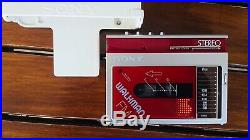
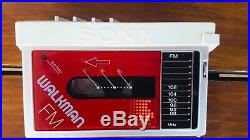
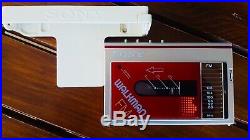
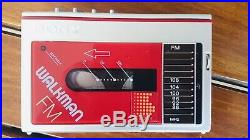
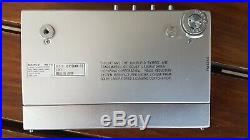
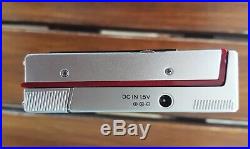
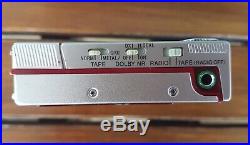
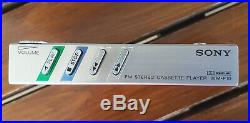
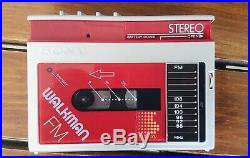
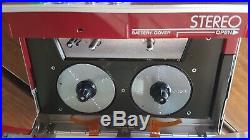
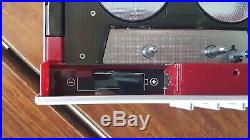

COSMETIC CONDITION PLEASE SEE PHOTOS(PERSONAL OPINION GOOD). WORKING CONDITION FOR PARTS OR REPAIR. THE WALKMAN IS POWER ON AND THE RED LED IS LIGHTNING. REWIND AND FAST FORWARD WORKING. RADIO IS NOT WORKING. Only player no ACCESORY! Overall cosmetic condition: 8 out of 10 (For Parts or Repair). For Parts or Repair. Some of the items I sell are nearly 30 years old! I always try to make careful description of overall item condition. Items considered as for parts or repair have high risk of low quality in condition or dysfunction. Despite being a fairly early model, the WM-10 was the smallest of all the cassette-playing Walkman models. Its tiny size is amazing even now, and represents a considerable achievement in the context of what was possible in the early 80s. The WM-10 was smaller even than the cassette it played and had to be slid open to make the cassette compartment large enough to take the tape. This of course meant that it became considerably larger before it was useful. Such practical shortcomings miss the point of the WM-10 however, as its main function was to demonstrate Sonys continuing technical leadership by producing yet another worlds smallest product. Making the WM-10 so small was not simply a case of taking the WM-2. And halving the size of each part. New techniques were required to achieve a worthwhile reduction in size. With the size of the cassette fixed, the other large parts in any cassette player are the battery and the motor. The motor was miniaturised by changing it from a cylindrical form (as in the WM-2, where the motor is about the same size as an AA battery) to a flat disc. The BSL (brushless and slotless) motor used in the WM-10 was based on techniques used for direct-drive turntables, though to make the tiny motor powerful enough it had to rotate very fast. The disc and magnet coils could be made very thin, but this still left the bearings, which had to be sturdy to maintain the small clearances required between the disc and the coils, to be housed somewhere. The clever solution to this problem was to place the bearing inside the centre of the supply spool, where it could be made large and long enough to function properly. The spool itself was driven by a large gear, so no access to its shaft was needed. WM-10 with body expanded to accept a cassette. The battery presented another problem. One answer would have been to use specialised cells, but these would soon have become a burden if not easily available. The decision to use a single AA type battery was a brave one, and backed up by more clever technology. The 1.5V available from this source was not enough to run the electronic parts of the amplifier and servo, so a step-up DC-DC converter was used to boost the voltage to a useful level. Sony had used these devices in the past, in models such as the TC-D5. But for the WM-10 something all together smaller was needed. The converter used in the WM-10 was made using miniature components on a thin, flexible printed circuit. This was then rolled up on itself into a tube and tucked down the side of the chassis. By these means, a compact assembly that was well screened from the rest of the circuitry was realised. The single AA battery was housed in a compartment next to the heads at the top of the machine, and usefully employed the depth in the case required for the heads to retract into. Other methods of keeping the size of the WM-10 small included the use of extra thin case materials, miniature surface mounted electronic parts and an unusually thin printed circuit panel with track work on both sides. Despite being very small, the WM-10 was not sparse on facilities. It included Dolby B NR, normal/chrome/metal tape compatibility and automatic stop in all modes. A switch inside the headphone socket prevented the power being turned on unless the headphones were connected, thus protecting the battery from waste. If the WM-10 did have a failing, it was that it was rather fragile, though subsequent models in the series addressed this problem. The item “SONY WALKMAN WM-F10 RED SONY WALKMAN VINTAGE 1983 POWERS ON FOR PARTS” is in sale since Wednesday, June 19, 2019. This item is in the category “Sound & Vision\Portable Audio & Headphones\Personal Cassette Players”. The seller is “sonykos” and is located in DRAMA. This item can be shipped worldwide.
- Brand: Sony
- Model: WM-F10
- Type: Mini Cassette Player (Walkman)
- Features: Cassette Playback
